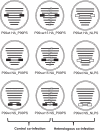Heterologous Packaging Signals on Segment 4, but Not Segment 6 or Segment 8, Limit Influenza A Virus Reassortment
- PMID: 28331085
- PMCID: PMC5432880
- DOI: 10.1128/JVI.00195-17
Heterologous Packaging Signals on Segment 4, but Not Segment 6 or Segment 8, Limit Influenza A Virus Reassortment
Abstract
Influenza A virus (IAV) RNA packaging signals serve to direct the incorporation of IAV gene segments into virus particles, and this process is thought to be mediated by segment-segment interactions. These packaging signals are segment and strain specific, and as such, they have the potential to impact reassortment outcomes between different IAV strains. Our study aimed to quantify the impact of packaging signal mismatch on IAV reassortment using the human seasonal influenza A/Panama/2007/99 (H3N2) and pandemic influenza A/Netherlands/602/2009 (H1N1) viruses. Focusing on the three most divergent segments, we constructed pairs of viruses that encoded identical proteins but differed in the packaging signal regions on a single segment. We then evaluated the frequency with which segments carrying homologous versus heterologous packaging signals were incorporated into reassortant progeny viruses. We found that, when segment 4 (HA) of coinfecting parental viruses was modified, there was a significant preference for the segment containing matched packaging signals relative to the background of the virus. This preference was apparent even when the homologous HA constituted a minority of the HA segment population available in the cell for packaging. Conversely, when segment 6 (NA) or segment 8 (NS) carried modified packaging signals, there was no significant preference for homologous packaging signals. These data suggest that movement of NA and NS segments between the human H3N2 and H1N1 lineages is unlikely to be restricted by packaging signal mismatch, while movement of the HA segment would be more constrained. Our results indicate that the importance of packaging signals in IAV reassortment is segment dependent.IMPORTANCE Influenza A viruses (IAVs) can exchange genes through reassortment. This process contributes to both the highly diverse population of IAVs found in nature and the formation of novel epidemic and pandemic IAV strains. Our study sought to determine the extent to which IAV packaging signal divergence impacts reassortment between seasonal IAVs. Our knowledge in this area is lacking, and insight into the factors that influence IAV reassortment will inform and strengthen ongoing public health efforts to anticipate the emergence of new viruses. We found that the packaging signals on the HA segment, but not the NA or NS segments, restricted IAV reassortment. Thus, the packaging signals of the HA segment could be an important factor in determining the likelihood that two IAV strains of public health interest will undergo reassortment.
Keywords: evolution; influenza virus; packaging; reassortment; segment mismatch.
Copyright © 2017 American Society for Microbiology.
Figures







Similar articles
-
H5N8 and H7N9 packaging signals constrain HA reassortment with a seasonal H3N2 influenza A virus.Proc Natl Acad Sci U S A. 2019 Mar 5;116(10):4611-4618. doi: 10.1073/pnas.1818494116. Epub 2019 Feb 13. Proc Natl Acad Sci U S A. 2019. PMID: 30760600 Free PMC article.
-
Seasonal H3N2 and 2009 Pandemic H1N1 Influenza A Viruses Reassort Efficiently but Produce Attenuated Progeny.J Virol. 2017 Aug 10;91(17):e00830-17. doi: 10.1128/JVI.00830-17. Print 2017 Sep 1. J Virol. 2017. PMID: 28637755 Free PMC article.
-
Positive Selection Drives Preferred Segment Combinations during Influenza Virus Reassortment.Mol Biol Evol. 2015 Jun;32(6):1519-32. doi: 10.1093/molbev/msv044. Epub 2015 Feb 23. Mol Biol Evol. 2015. PMID: 25713211 Free PMC article.
-
Implications of segment mismatch for influenza A virus evolution.J Gen Virol. 2018 Jan;99(1):3-16. doi: 10.1099/jgv.0.000989. Epub 2017 Dec 15. J Gen Virol. 2018. PMID: 29244017 Free PMC article. Review.
-
Constraints, Drivers, and Implications of Influenza A Virus Reassortment.Annu Rev Virol. 2017 Sep 29;4(1):105-121. doi: 10.1146/annurev-virology-101416-041726. Epub 2017 May 26. Annu Rev Virol. 2017. PMID: 28548881 Review.
Cited by
-
Equine Influenza Virus in Asia: Phylogeographic Pattern and Molecular Features Reveal Circulation of an Autochthonous Lineage.J Virol. 2019 Jun 14;93(13):e00116-19. doi: 10.1128/JVI.00116-19. Print 2019 Jul 1. J Virol. 2019. PMID: 31019053 Free PMC article.
-
Reovirus Efficiently Reassorts Genome Segments during Coinfection and Superinfection.J Virol. 2022 Sep 28;96(18):e0091022. doi: 10.1128/jvi.00910-22. Epub 2022 Sep 12. J Virol. 2022. PMID: 36094315 Free PMC article.
-
Conserved structural RNA domains in regions coding for cleavage site motifs in hemagglutinin genes of influenza viruses.Virus Evol. 2019 Aug 21;5(2):vez034. doi: 10.1093/ve/vez034. eCollection 2019 Jul. Virus Evol. 2019. PMID: 31456885 Free PMC article.
-
Analysis of the Variability in the Non-Coding Regions of Influenza A Viruses.Vet Sci. 2018 Aug 25;5(3):76. doi: 10.3390/vetsci5030076. Vet Sci. 2018. PMID: 30149635 Free PMC article.
-
Population Diversity and Collective Interactions during Influenza Virus Infection.J Virol. 2017 Oct 27;91(22):e01164-17. doi: 10.1128/JVI.01164-17. Print 2017 Nov 15. J Virol. 2017. PMID: 28855247 Free PMC article. Review.
References
-
- Shaw ML, Palese P. 2013. Orthomyxoviridae, p 1151–1185. In Knipe DM, Howley PM, Cohen JI, Griffin DE, Lamb RA, Martin MA, Racaniello VR, Roizman B (ed), Fields virology, 6th ed, vol 1 Lippincott Williams & Wilkins, Philadelphia, PA.
-
- Garten RJ, Davis CT, Russell CA, Shu B, Lindstrom S, Balish A, Sessions WM, Xu X, Skepner E, Deyde V, Okomo-Adhiambo M, Gubareva L, Barnes J, Smith CB, Emery SL, Hillman MJ, Rivailler P, Smagala J, de Graaf M, Burke DF, Fouchier RAM, Pappas C, Alpuche-Aranda CM, López-Gatell H, Olivera H, López I, Myers CA, Faix D, Blair PJ, Yu C, Keene KM, Dotson PD, Boxrud D, Sambol AR, Abid SH, St. George K, Bannerman T, Moore AL, Stringer DJ, Blevins P, Demmler-Harrison GJ, Ginsberg M, Kriner P, Waterman S, Smole S, Guevara HF, Belongia EA, Clark PA, Beatrice ST, Donis R, Katz J, Finelli L, Bridges CB, Shaw M, Jernigan DB, Uyeki TM, Smith DJ, Klimov AI, Cox NJ. 2009. Antigenic and genetic characteristics of swine-origin 2009 A(H1N1) influenza viruses circulating in humans. Science 325:197–201. doi:10.1126/science.1176225. - DOI - PMC - PubMed
Publication types
MeSH terms
Substances
Grants and funding
LinkOut - more resources
Full Text Sources
Other Literature Sources
Miscellaneous

